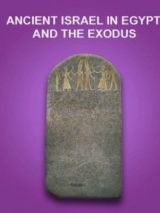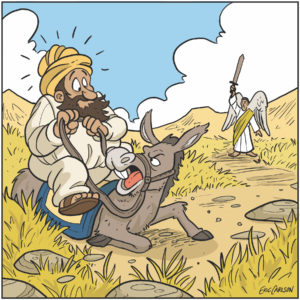Examining the figure of Balaam in the Bible
Nathan Steinmeyer March 18, 2022 0 Comments 17 views
Balaam son of Beor is one of the most enigmatic figures in the Hebrew Bible, and one of the earliest to be referenced outside the biblical text. Variously presented as a diviner or prophet, and as someone who walked the line between enemy and ally, the intriguing figure of Balaam even captured the attention of later Christian and Jewish authors. Presentations of this figure vary wildly, with some traditions presenting him as a forerunner of the magi, while in other traditions he is seen as no more than a charlatan. So who is Balaam son of Beor?
This Bible History Daily post is the first in a series that will explore this enigmatic figure and what we learn of him from the Bible and archaeology.


Balaam Son of Beor in the Bible
Balaam’s main narrative (Numbers 22–24) is included within the wider story of ancient Israel’s entrance into the land of Canaan and its subjugation of the lands east of the Jordan River. Within this context, Balaam is introduced in Numbers 22, while the Israelites are camped on the plains of Moab. Fearing the Israelites, King Balak and the elders of Moab send away for a foreign prophet and diviner, Balaam son of Beor, requesting that he curse the Israelites. But unfortunately for Balak and the Moabite elders, the plan backfires.
Despite initial reluctance, Balaam eventually goes with the Moabite messengers, with the warning that he can only speak the words that God gives to him. Upon his arrival, Balak takes Balaam to three separate places where they can see the encamped Israelites. Each time, Balak builds seven altars for the gods and sacrifices bulls and rams upon them, to gain the approval of the gods for his request. Yet, each time, instead of cursing the Israelites, Balaam blesses them, declaring, “How can I curse whom God has not cursed?” (Numbers 23:8). Balaam then gives an unprovoked fourth oracle, after which he departs the scene.
In Numbers 22–24, Balaam son of Beor is thus presented in a positive light. But later, in chapter 31, we see Balaam reappear, though in a decidedly more negative context. Here, two more snippets of the Balaam narrative appear, interspersed amongst the narrative of Israel’s war with the Midianites. The first additional note comes in 31:8, where Balaam is said to have been slain alongside five kings of Midian in battle with the Israelites. The second note is found in Numbers 31:16, where Balaam is implicated in the matter of Peor (found in Numbers 25), in which the Moabite women lead the men of Israel into apostasy. Both instances, however, are thought to be later additions and do not connect directly to the main Balaam narrative of Numbers 22–24.
Balaam: Who Was He and What Did He Do?
Despite being mentioned in connection with Midianite kings in Numbers 31, Balaam is not a Midianite. Neither is he a Moabite like Balak. Instead, he is an Aramean. This is stated explicitly in Balaam’s first oracle where he says “Balak has brought me from Aram” (Numbers 23:7). Numbers 22:5 specifically states that he is from the town of Pethor, generally accepted to be the ancient Aramean city of Pitru,1 located in what is today northern Syria. While some scholars dispute Balaam’s Aramean background,2 the appearance of the name Balamu for an Aramean chieftain in the eighth century B.C.E.3 favors Balaam’s Aramean heritage.
In the Numbers narrative, Balaam’s designation as an Aramean underscores his position as a foreigner who has no connection to the conflict between the Moabites and the Israelites. Similarly, through understanding his profession, we gain a better sense of how the biblical writers viewed Balaam’s role in the episode. Although the word “prophet” is widely used in English, the ancient world possessed an astonishing array of different “prophetic” figures, many of whom functioned quite differently from the Hebrew prophets we know from the Bible.
Balaam the Prophet?
Balaam’s particular reception of divine information can be divided into two categories: unsolicited omens and solicited omens. Examples of unsolicited omens can be seen in the three divine messages he receives in Numbers 22. Balaam receives the first two messages at night, without mention of any action on his part to receive them. Similarly, he received a third message when an angel appears to him while he is traveling to Moab on his donkey. These are not unlike the typical omens and divine commandments received by the Hebrew prophets.
However, some of Balaam’s actions designate him as something beyond a typical prophet—a diviner. Divination is about the reading of signs on the organs of a sacrificial animal, to divine the will of the gods. One example of such divinatory practice is found in Numbers 22:7. Although the Hebrew expression has typically been translated “with the fees for divination in their hand,” a better translation is “with divination in their hands.”4 This plausibly refers to the practice of making models of a sacrificed animal’s organs to receive the interpretation of a diviner who was not present at the original slaughter. Although not mentioned often in the Hebrew Bible, the use of this sort of divination was very common in the ancient Near East and is known from Hazor and Megiddo.
Balaam the Diviner?
If Balaam was a diviner, it would be unusual for him to also receive unsolicited omens, but certainly not unheard of.5 Yet, why would it matter? If Numbers 22:7 is indeed a reference to an omen model brought by the Moabites to Balaam, then it would explain much of the rest of Balaam’s story. The reason for Balak sending the omen model to Balaam would almost certainly have been a desire for a second opinion due to the overwhelmingly bad signs of the omen. Upon receiving the model, Balaam would have read the signs and known that God had blessed Israel. This contextualizes Balaam’s constant declaration that he cannot go beyond the command of Yahweh. This is not a statement of his devotion to God, but a display of the terms of his business and an acknowledgment that no amount of payment can force the omens to change.
Understanding Balaam as a diviner provides insight into two further actions of Balaam: his journey with Balak to see the different locations where the Israelites are camped, and his consistent sacrificial activities before delivering oracles. First, the placement of the oracles at locations within sight of the Israelite camp follows well the standard divinatory practice, in which it was necessary to either be within eyesight of the object of the requested omen or to have a physical talisman associated with the object.6 Thus, Balaam would have needed the Israelite camp to be in view before he could call upon the deities to answer his request. Second, the continued sacrifice of animals would thus be contextualized as a ritual sacrifice intended to bring the favor of the gods. This would have been standard practice, although the offerings were typically not this extravagant.7
Balaam: Ally or Enemy?
What impact does Balaam’s profession have on the question of whether he was friend or foe? As will be discussed in future posts, the biblical authors quickly pivoted from presenting Balaam in a favorable light. Much of this shift can be understood in view of Balaam’s position as a foreign diviner and the biblical prohibition against such religious practices (Deuteronomy 18:9–14).8 In turn, the positive portrayal of Balaam son of Beor in Numbers is not a depiction of an ally, but simply a reliable spokesperson for the divine who, despite all of Balak’s sacrifices, has chosen to bless the Israelites instead of cursing them.
Notes:
1 Walter Gross, Bileam. Literar- und formkritische Untersuchung der Prosa in Num 22-24 (München: Kösel Verlag, 1974).
2 Jonathan Miles Robker, Balaam in Text and Tradition (Tübingen: Mohr Siebeck, 2019).
3 Paul-Eugène Dion, “Les araméens du Moyen-Euphrate au VIIIe siècle à la lumière des inscriptions des maîtres de Suhu et Mari,” in J. Emerton, ed., Congress Volume (Leiden: Brill, 1995), pp. 53–74, n. 106.
4 Victor Hurowitz, “The Expression Uqsamim Beyadam (Numbers 22:7) in Light of Divinatory Practice from Mari” Hebrew Studies 33 (1992), pp. 5–15.
5 Jean-Marie Durand, Archives épistolaires de Mari I/1, ARM 26/1 (Paris: Editions Rescherche sur les Civilisations, 1988), n. 216.
6 See note 5, n. 156 and n. 177.
7 Yoram Cohen, The Babylonian šumma immeru Omens (Munster: Zaphon, 2020).
8 Joel S. Burnett, “Prophecy in Transjordan: Balaam Son of Beor,” in Christopher Rollston, ed., Enemies and Friends of the State: Ancient Prophecy in Context (University Park, PA: Eisenbrauns, 2018), pp. 137–204.
All-Access members, read more in the BAS Library:
Before Tea Leaves: Divination in Ancient Babylonia
Fragments from the Book of Balaam Found at Deir Alla
Not a BAS Library or All-Access Member yet? Join today.


